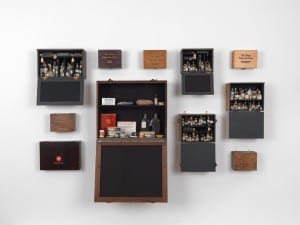Simon Oldfield is the director of Simon Oldfield Gallery in Covent Garden, London. Simon is passionate about what he does and over the past few years he has successfully established the gallery as one of the most exciting new spaces in London. The exhibition ran from 10 February – 19 March 2011, Ben Ashton: At Home with the Ashtons.
www.simonoldfield.com.
What was your background prior to opening the gallery?
The first thing to say is that I really love my job. Owning a gallery in London and working with some of the most exciting British contemporary artists has always been my goal. Prior to opening the gallery, I worked closely with a loyal group of private collectors and corporate collections, providing art consultancy. This was an excellent foundation for the gallery. I am also a corporate lawyer and, what feels like many years ago, I worked in a large City law firm. This background is extremely valuable.
Are you excited to be working with Ben Ashton for the current exhibition?
Absolutely. Ben Ashton has been working with the gallery since the beginning and we have established a very successful, collaborative working relationship. This has resulted in some incredible opportunities, most recently with Ben exhibiting at the House of Voltaire in support of Studio Voltaire. At Home with the Ashtons, Ben’s second solo show with the gallery distils the domestic rituals of life. It’s exciting because he challenges us to look at what we are seeing by presenting us with a unique perspective on a familiar world. For me, there is a brutal honesty in the work, which makes it some of his most engaging and arresting work to date.
The gallery only opened in 2008 and has been in its current location since June 2010, you’ve accomplished a great deal – what’s your vision?
The past few years have been extremely exciting. Looking back there have been some clear milestones. Opening our permanent space in central London with New Symphony was a great moment, particularly as it was so well received and Tim Ellis’ work from the show was acquired by the Saatchi Gallery for Newspeak: British Art Now. The shows that followed, Base Metal and Modern Love, were also well received and it’s been an enormous privilege to exhibit work by so many brilliant artists, emerging and established. Central to the future is continuing to build strong relationships with excellent artists and put on fantastic shows.
The exhibition raises important questions around contemporary painting and art historical definitions of Modernity; have you reached your own conclusion about the place of the “visual” in contemporary culture?
There is a continuous debate surrounding the relationship contemporary artists have with art historical definitions of Modernity, but I don’t find conclusions as interesting as questions, especially when it comes to contemporary art. It’s easy to deny the potential of the visual to carry complex and sophisticated ideas; the visual is a language – and can communicate, but not necessarily explain. At Home with the Ashtons is underpinned by the visual generosity of the work, but like most disciplines, art practice has its own set of conventions and precedents. It’s often useful to have a rudimentary sense of the art historical context in which a contemporary artwork might be seen, but unlike academic specialisms, this is not the only way in which an audience might engage with a work of art.
As an art dealer and gallerist, do you find it a challenge to couple your commitment to emerging artists alongside commercial constraints?
I don’t see it is as a challenge, but it’s not always easy! It’s crucial that we don’t compromise on anything important to the success of an exhibition or project, so the challenge becomes working out how we make something happen. This essentially results in us having to work extremely hard and build good relationships with the collectors who continue to support the gallery and the artists. This year we are going to have to work even harder because we are hoping to realise a few very ambitious projects including an exhibition in LA, where many of the gallery’s clients are based. Art consultancy and secondary market sales are also vital to the success of the gallery programme and my commitment to emerging artists.
How do you find the artists you represent? What kind of relationship exists between you and the artist?
I spend the majority of my time surrounded by artists, curators, gallerists and critics – defining when work begins and ends is quite difficult! So finding artists has become a very organic process, which is underpinned by countless studio visits, attending degree shows and personal recommendations. Each artist is different, so the relationships can differ enormously. But central to every relationship is trust and respect.
What are your aims for the gallery and what else does your programme hold in 2011?
The gallery is planning some really exciting exhibitions and hopefully the burgeoning number of visitors to the gallery will continue to find a variety of both new and established artists exhibiting here. 2011 begins with Ben Ashton’s solo show, followed by Jonathan Trayte’s first solo exhibition since leaving the RA in April. In May, Tim Ellis and I are curating an exciting group exhibition. Later this year, solo shows by two young artists, Sam Knowles and Ryan Leigh. Towards the end of the year, we will be working on a project with Katie Cuddon, who was recently awarded the inaugural ceramics fellowship at Camden Arts Centre. In addition to the gallery programme, we are planning a number of off-site and international projects. I have also been appointed to curate the art programme at the Pollen Street Social, a new major restaurant in Mayfair. It’s an exciting project and a great opportunity for many of the artists working with the gallery.





